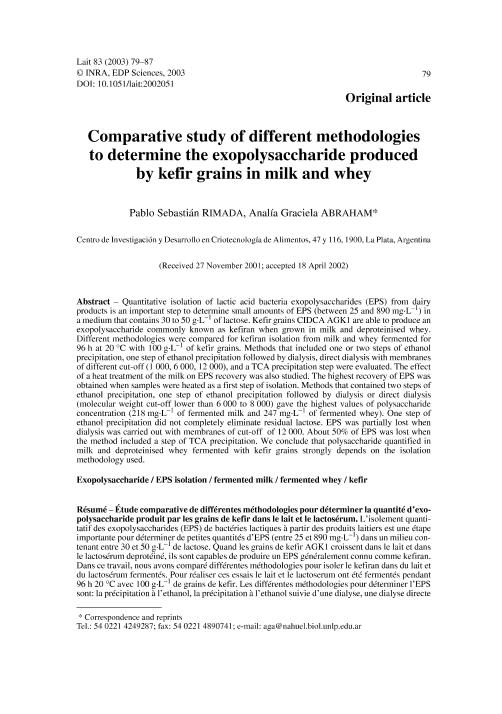Artículo
Comparative study of different methodologies to determine the exopolysaccharide produced by kefir grains in milk and whey
Fecha de publicación:
01/2003
Editorial:
EDP Sciences
Revista:
Lait
ISSN:
0023-7302
Idioma:
Inglés
Tipo de recurso:
Artículo publicado
Clasificación temática:
Resumen
Quantitative isolation of lactic acid bacteria exopolysaccharides (EPS) from dairy products is an important step to determine small amounts of EPS (between 25 and 890 mg·L-1) in a medium that contains 30 to 50 g·L-1 of lactose. Kefir grains CIDCA AGK1 are able to produce an exopolysaccharide commonly known as kefiran when grown in milk and deproteinised whey. Different methodologies were compared for kefiran isolation from milk and whey fermented for 96 h at 20 °C with 100 g·L-1 of kefir grains. Methods that included one or two steps of ethanol precipitation, one step of ethanol precipitation followed by dialysis, direct dialysis with membranes of different cut-off (1 000, 6 000, 12 000), and a TCA precipitation step were evaluated. The effect of a heat treatment of the milk on EPS recovery was also studied. The highest recovery of EPS was obtained when samples were heated as a first step of isolation. Methods that contained two steps of ethanol precipitation, one step of ethanol precipitation followed by dialysis or direct dialysis (molecular weight cut-off lower than 6 000 to 8 000) gave the highest values of polysaccharide concentration (218 mg·L-1 of fermented milk and 247 mg·L-1 of fermented whey). One step of ethanol precipitation did not completely eliminate residual lactose. EPS was partially lost when dialysis was carried out with membranes of cut-off of 12 000. About 50% of EPS was lost when the method included a step of TCA precipitation. We conclude that polysaccharide quantified in milk and deproteinised whey fermented with kefir grains strongly depends on the isolation methodology used.
Palabras clave:
EPS ISOLATION
,
EXOPOLYSACCHARIDE
,
FERMENTED MILK
,
FERMENTED WHEY
,
KEFIR
Archivos asociados
Licencia
Identificadores
Colecciones
Articulos(CIDCA)
Articulos de CENTRO DE INV EN CRIOTECNOLOGIA DE ALIMENTOS (I)
Articulos de CENTRO DE INV EN CRIOTECNOLOGIA DE ALIMENTOS (I)
Citación
Rimada, Pablo Sebastián; Abraham, Analia Graciela; Comparative study of different methodologies to determine the exopolysaccharide produced by kefir grains in milk and whey; EDP Sciences; Lait; 83; 1; 1-2003; 79-87
Compartir
Altmétricas




